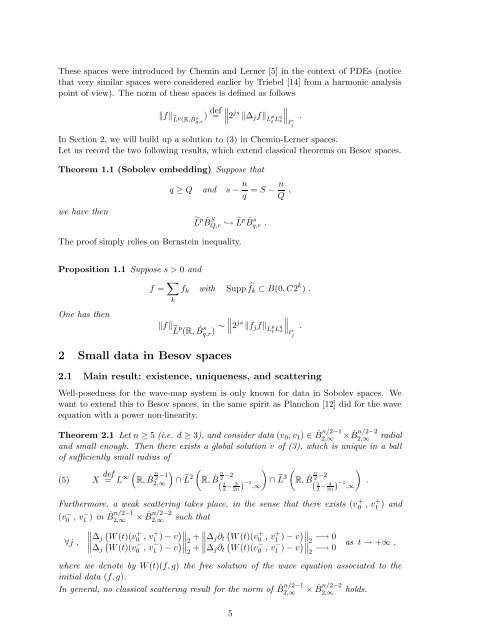Besov spaces and self-similar solutions for the wave-map equation
Besov spaces and self-similar solutions for the wave-map equation
Besov spaces and self-similar solutions for the wave-map equation
You also want an ePaper? Increase the reach of your titles
YUMPU automatically turns print PDFs into web optimized ePapers that Google loves.
These <strong>spaces</strong> were introduced by Chemin <strong>and</strong> Lerner [5] in <strong>the</strong> context of PDEs (notice<br />
that very <strong>similar</strong> <strong>spaces</strong> were considered earlier by Triebel [14] from a harmonic analysis<br />
point of view). The norm of <strong>the</strong>se <strong>spaces</strong> is defined as follows<br />
fe Lp (R, B˙ s )<br />
q,r<br />
def<br />
<br />
<br />
= 2 js ∆jf p<br />
L<br />
<br />
<br />
t Lq <br />
x ℓr j<br />
In Section 2, we will build up a solution to (3) in Chemin-Lerner <strong>spaces</strong>.<br />
Let us record <strong>the</strong> two following results, which extend classical <strong>the</strong>orems on <strong>Besov</strong> <strong>spaces</strong>.<br />
Theorem 1.1 (Sobolev embedding) Suppose that<br />
we have <strong>the</strong>n<br />
q ≥ Q <strong>and</strong> s − n<br />
q<br />
L p ˙ B S Q,r ↩→ L p ˙ B s q,r .<br />
The proof simply relies on Bernstein inequality.<br />
= S − n<br />
Q ,<br />
Proposition 1.1 Suppose s > 0 <strong>and</strong><br />
f = <br />
fk with Supp fk ⊂ B(0, C2 k ) .<br />
One has <strong>the</strong>n<br />
k<br />
f L p (R, ˙ B s q,r) ∼<br />
2 Small data in <strong>Besov</strong> <strong>spaces</strong><br />
<br />
<br />
2 js fjf L p<br />
<br />
<br />
t Lq <br />
x ℓr j<br />
2.1 Main result: existence, uniqueness, <strong>and</strong> scattering<br />
Well-posedness <strong>for</strong> <strong>the</strong> <strong>wave</strong>-<strong>map</strong> system is only known <strong>for</strong> data in Sobolev <strong>spaces</strong>. We<br />
want to extend this to <strong>Besov</strong> <strong>spaces</strong>, in <strong>the</strong> same spirit as Planchon [12] did <strong>for</strong> <strong>the</strong> <strong>wave</strong><br />
<strong>equation</strong> with a power non-linearity.<br />
Theorem 2.1 Let n ≥ 5 (i.e. d ≥ 3), <strong>and</strong> consider data (v0, v1) ∈ ˙ B n/2−1<br />
2,∞ × ˙ B n/2−2<br />
2,∞ radial<br />
<strong>and</strong> small enough. Then <strong>the</strong>re exists a global solution v of (3), which is unique in a ball<br />
of sufficiently small radius of<br />
(5) X def<br />
<br />
∞<br />
= L R, ˙B n<br />
2 −1<br />
<br />
∩ L 2<br />
<br />
<br />
∩ L 3<br />
<br />
<br />
.<br />
2,∞<br />
R, ˙B n<br />
2 −2<br />
( 1<br />
2<br />
− 3<br />
2n) −1 ,∞<br />
.<br />
.<br />
R, ˙B n<br />
2 −2<br />
( 1<br />
2<br />
− 4<br />
3n) −1 ,∞<br />
Fur<strong>the</strong>rmore, a weak scattering takes place, in <strong>the</strong> sense that <strong>the</strong>re exists (v + 0 , v+ 1 ) <strong>and</strong><br />
(v − 0 , v− 1 ) in ˙ B n/2−1<br />
2,∞ × ˙ B n/2−2<br />
2,∞ such that<br />
∀j ,<br />
<br />
+<br />
∆j W (t)(v 0 , v + 1 ) − v + 2 <br />
+<br />
∆j∂t W (t)(v 0 , v + 1 ) − v <br />
−→ 0 2<br />
∆j<br />
−<br />
W (t)(v0 , v − 1 ) − v + 2 <br />
∆j∂t<br />
−<br />
W (t)(v0 , v − 1 ) − v −→ 0 2<br />
as t → +∞ ,<br />
where we denote by W (t)(f, g) <strong>the</strong> free solution of <strong>the</strong> <strong>wave</strong> <strong>equation</strong> associated to <strong>the</strong><br />
initial data (f, g).<br />
In general, no classical scattering result <strong>for</strong> <strong>the</strong> norm of ˙ B n/2−1<br />
2,∞<br />
5<br />
× ˙ B n/2−2<br />
2,∞<br />
holds.
















